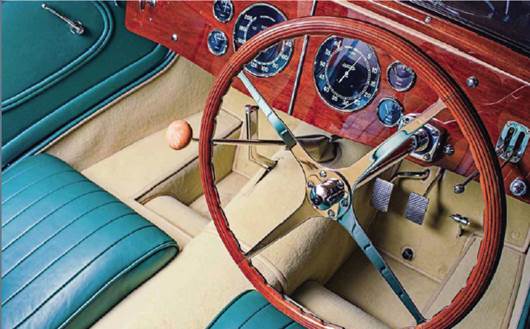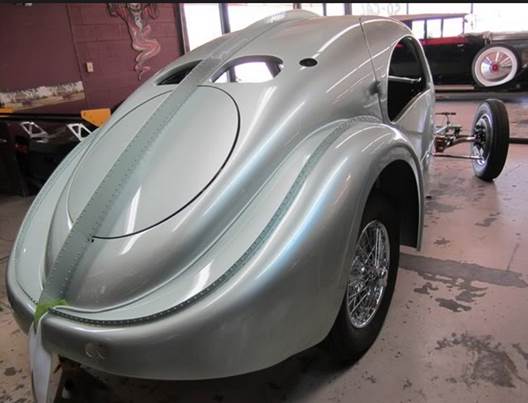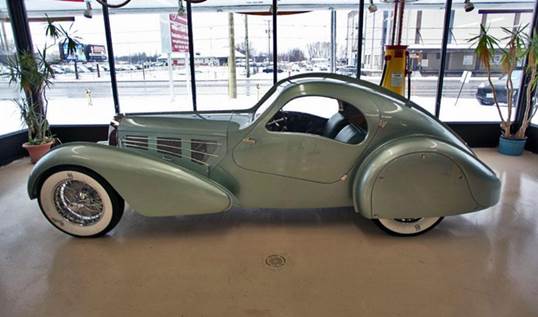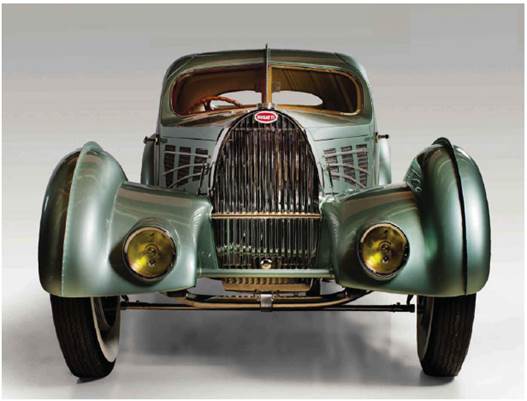After months of trial and error the
material was finally mastered and the build began in earnest. The chassis
itself was so complete that it was a very easy process to restore it, even to
the high level that I demanded of my staff. We knew that the Aerolithe's engine
was a basic non-supercharged 3.3-litre straight-eight that, in order to allow
for a lower bonnet profile, had been moved about 90mm rearwards from the
standard position of the radiator hovering over the front axle. This meant the
radiator and cowl could be positioned behind and lower than the front axle,
something quite visible in pictures of the Paris show car. Apart from a need to
create two new rear engine mounts the job was accomplished with no fuss. But
then some discoveries put us in hot water with members of the old guard.

We told all concerned that we really did
not care what the chassis of the original car was, as we were building the
non-supercharged shortened-standard-chassis number 57104 and mounting
Aerolithe-style coachwork on it. The actual Aerolithe became one of the great
automotive mysteries after it disappeared sometime after a visit to England in
1936. I have always harbored the suspicion that, as an ageing and useless
design prototype, it was probably torn down for its valuable mechanical bits
and pieces at the factory, which was financially stressed at the time.

The
actual Aerolithe became one of the great automotive mysteries after it
disappeared sometime after a visit to England in 1936.
The common understanding, which I shared
until I built the car, was that the Aerolithe, while not supercharged, sat on
an S chassis, the one common to all three Atlantics for which the Aerolithe was
the prototype. Some go so far as to maintain that the car was built on a T57 S
gondola chassis, which curved to a point at the back. That chassis was built to
accommodate a car that resembled a T59 GP car called the T57 Torpedo TT, which
was being built at the same time. We checked this theory very closely, as its
supporters were strident, and came to the conclusion that the coupe's body
would not sit on a gondola chassis and allow space for the fuel tank and spare
tire, nor would the steering box require the clearly photographed bulge in the
coachwork that was dictated by a standard chassis. It would have also needed
some very odd outriggers to support the coachwork at the rear, which were
totally impractical.
What we found was that a lot of armchair
theories were not viable in the real world of building a car, either now or in
1935. In fact the Aerolithe coachwork sits very comfortably on a shortened
standard chassis with virtually no modifications. An S chassis would have
called for an unlikely amount of unnecessary engineering. The last coffin nail,
I believe, is that the SC chassis was not developed until the Aerolithe was
almost complete. It would have taken the coachbuilders months to wrangle the
magnesium alloy into the Aerolithe and I am sure they would not have dismounted
the exhibition coachwork to plink it onto a brand new chassis that was not
featured anywhere on the 1935 Paris Salon Bugatti stand.
The storm of controversy that these
discoveries created was mystifying, as we were not trying to prove anything but
rather just reporting what we were finding.

That
chassis was built to accommodate a car that resembled a T59 GP car called the
T57 Torpedo TT, which was being built at the same time.
Another point of contention was our choice
of color for the car. Along with everyone else I had always assumed that the
car was silver. Mind you, in those days, silver was the German national racing
color. Once, at a Concours where I was displaying the T59,1 spoke to an elderly
Frenchman who had served his apprenticeship with Bugatti. We chatted through an
interpreter and I told him my next project might be the Aerolithe recreation.
He recalled sweeping up around the car and that it was codenamed Crème de
Menthe.
A couple of years later I came across a
1936 painting by one of Bugatti's designers that was given to Jean Bugatti as a
gift. In it the Aerolithe is represented flying down a springtime road
surrounded by fields of flowers and blossoming trees. The color? A delightful
green, like a mixed crème de menthe.
It would be hard to believe that the
painter would present this painting to the car's creator in the wrong color, so
I tested it by taking a photo of a bent spray-out and transferred it to
black-and-white. It looks exactly like the color in those photos taken back in
1935.
A major feature of the Aerolithe and all
the cars on the 1935 stand were the two-sided whitewall tires, unusual in
Europe. We tried to find a set, as to create the car and not have the right
tires on it would have driven me crazy. The only solution was to make them.
After a month's pursuit of Goodrich and
Goodyear (who share the old Dunlop rights) we finally got permission to
recreate the tires with the same markings, lettering and script. All the
markings were created in white rubber for application on the tires; Goodyear
had insisted that only vintage-style Dunlops be used, so we had to get the
correct size and have the white area carved out on both sides so that the
whitewall could be vulcanized and the markings and lettering then vulcanized in
place. Recently I bought a Delahaye from Spain and it had one original
series-90 Dunlop black wall on it. When we compared our markings to the
originals on the black wall we were absolutely exact. It was quite an
accomplishment for our project leader, who spent almost a year on the tires and
did all the scaling and template cutting.

A
major feature of the Aerolithe and all the cars on the 1935 stand were the
two-sided whitewall tires, unusual in Europe.
Now the project is winding down and the
car's future is being mapped out. To my delight, the reception we're getting is
absolutely wonderful. The car is one of the main stories in the first season of
a major TV series being shot at my premises and we are entertaining requests to
exhibit it from museums all over the world. It has been an idea, an obsession,
a business proposition, a controversy, a headache, a constant irritant and
finally a magnificent cooperative work of art that I have had the pleasure and
honor of building with a team of gifted individuals.
I had no idea when I was staring at those
grainy black-and-white photographs so many years ago that this day would be so
long coming or, indeed, if it ever would. Looking back there is very little I
would change; even the disasters were sort of fun and I love nothing better
than a good fight. The car itself, I expect, will outlast me and, while I have
my name on more than 1000 restorations so far, I think this is one I will
remember as a high point.
The realization of what had been
accomplished didn't sink in until recently. We were in the middle of a photo
shoot with the Bugatti; and the photographer, who was also the director of the
pilot for our TV series, walked around the car in some wonderment, then turned
to me and said: 'You made this.'
Yeah, I guess I did.
|
1934 Bugatti Aerolithe Recreation
§ Engine: 3257cc straight-eight, DOHC,
Stromberg dual-throat UUR2 up draught carburetor
§ Power : 135bhp@4500rpm
§ Torque: 1811b ft @2A00rpm
§ Transmission: Four-speed manual,
rear-wheel drive
§ Steering: Worm and roller
§ Suspension: Front: split axle,
semi-elliptical leaf springs, Hartford friction dampers. Rear: live axle,
reversed quarter-elliptic leaf springs, Hartford friction dampers
§ Brakes: Drums, cable operated
§ Weight: c1450kg
§ Performance: Top speed 120mph
|